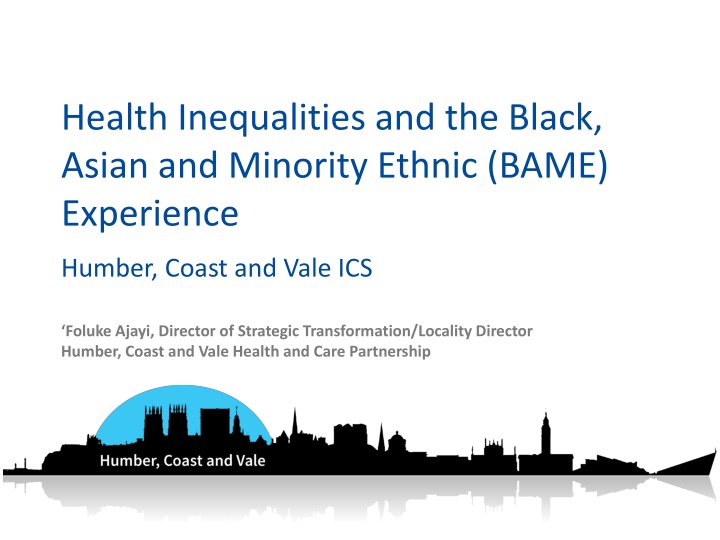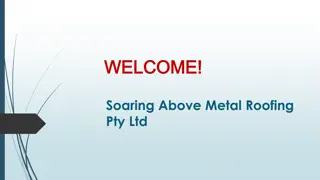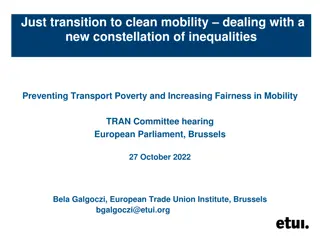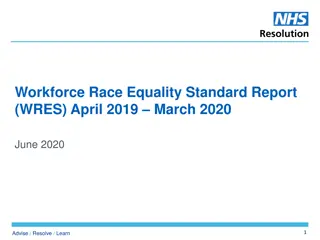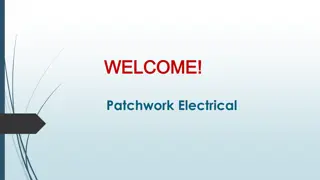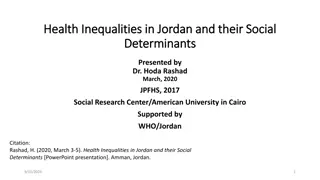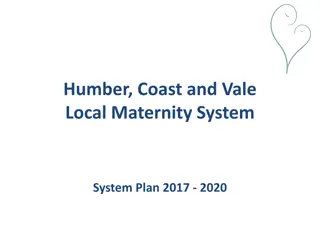Addressing Health Inequalities in Humber, Coast, and Vale: Insights from BAME Experience
Humber, Coast, and Vale Health and Care Partnership focuses on tackling health inequalities, especially regarding the Black, Asian, and Minority Ethnic (BAME) communities. The region's demographics, challenges, and initiatives like the BAME Staff Network of Networks are highlighted. Key issues such as unemployment rates, smoking prevalence, and disparities in life expectancy are being addressed to improve overall well-being and healthcare access.
Download Presentation

Please find below an Image/Link to download the presentation.
The content on the website is provided AS IS for your information and personal use only. It may not be sold, licensed, or shared on other websites without obtaining consent from the author.If you encounter any issues during the download, it is possible that the publisher has removed the file from their server.
You are allowed to download the files provided on this website for personal or commercial use, subject to the condition that they are used lawfully. All files are the property of their respective owners.
The content on the website is provided AS IS for your information and personal use only. It may not be sold, licensed, or shared on other websites without obtaining consent from the author.
E N D
Presentation Transcript
Health Inequalities and the Black, Asian and Minority Ethnic (BAME) Experience Humber, Coast and Vale ICS Foluke Ajayi, Director of Strategic Transformation/Locality Director Humber, Coast and Vale Health and Care Partnership
Background Humber, Coast and Vale Health and Care Partnership (ICS) originally formed as a Sustainability and Transformation Partnership in 2016; confirmed as an ICS in April 2020 National reforms are taking place bringing all health and care systems to ICS status by April 2022 From April 2022, ICSs will become legislated bodies directly responsible for the health and wellbeing of their populations, and will be able to be held to account for this.
Humber, Coast and Vale 1.7 million people 4 acute hospital trusts (operating across 9 sites) Circa 50,000 staff across health and adult social care 3 mental health trusts Total budget of approx. 3.5bn 4 community / not for profit providers 450 care homes 34 Primary Care Networks 140 home care companies 2 ambulance trusts 7 hospices 6 clinical commissioning groups (CCGs) 6 local authorities 1000s of voluntary and community sector organisations
HCV Demographics HCV population: 1.7 million citizens BAME population sits just under 60,000 = 3.6% The higher proportion (circa 20%) of BAME workforce in HCV requires greater reflection and representation at Board levels across the ICS (which are currently majority white) Steve Russell, Executive Lead for HCV s BAME Programme, is leading a newly-formed BAME Staff Network of Networks based on the successful West Yorkshire & Harrogate model.
Overview: Health Inequalities Nearly a quarter of our population live in areas classed as the most deprived in England Unemployment rates also vary across the region from 3.4% in York to 9.8% in Hull Ageing population 20% of HCV population is over 65 (compared to 17% nationally) Some of the worst rates of smoking prevalence in England Air pollution and climate change the Humber s CO2 emissions are double national levels (largely due to industry, ports, infrastructure)
Health Inequality: Life Expectancy Huge difference in healthy life expectancy between poorer and richer areas Healthy life expectancy for females, 2009-2013 (years) Lowest in HCV area: 53.1 (East Hull) Highest in HCV area: 73.5 (Richmondshire)
BAME Health Inequalities (1) It is well known that BAME colleagues and communities have been disproportionately affected by the Covid-19 pandemic Ongoing reviews by health systems and the UK Government are taking place to understand what is driving this inequality (e.g. Public Health England, 2020 and WYH ICS Report, 2020) Black Lives Matter, 2020 protests and ongoing movement We know there is much more work to do before we can see a health system free of systemic injustice and health inequality.
BAME Health Inequalities (2) No existing HCV-specific data on BAME health inequalities Baseline health inequalities assessment for HCV is in the pipeline and will include BAME communities The support needs of BAME colleagues and white allyship is also a priority of the new Staff Network of Networks led by Steve Russell West Yorkshire & Harrogate ICS Report, October 2020 Review into the impact of COVID-19 on health inequalities and support needed for Black, Asian and minority ethnic (BAME) communities.
West Yorkshire & Harrogate ICS Report At a glance: - BAME communities are vulnerable to poorer health outcomes - There are key factors that can increase inequalities further such as intersectionality with deprivation - Mental health outcomes are particularly poorer for BAME groups - Covid-19 and the economic recession is driving greater inequality Summary of recommendations: 1) Improve access to safe work for BAME people 2) Ensure the ICS s leadership is reflective of communities 3) Use information and data to plan services that meet different groups needs through population planning 4) Reduce inequalities in mental health outcomes by ethnicity https://www.wyhpartnership.co.uk/publications/tackling-health- inequalities-for-bame-communities-and-colleagues
What causes Health Inequalities? What causes these inequalities is the subject of much debate but much can be linked to the deeper impact of wider societal inequalities beyond the operation of health and social care services. These include broader environmental, social and economic factors that exert a profound ability to shape health outcomes for communities
The Role of Prevention Many diseases and conditions are preventable Poverty, poor housing, poor education, poor employment opportunities, exposure to crime, discrimination and prejudice, and environment all affect people s ability to thrive and live well Covid-19 has shone a light on the role health inequalities (but also preventative action) play in health outcomes for populations Prevention goes beyond individual responsibility, which is where the role of the State/Government/System comes in
Prevention and Population Health Public Health the determinants of health: healthcare is not the main determinant of health.
Prevention never more necessary Huge increase in incidence and prevalence of chronic disease Number of people on a QOF disease register in 11 GP practices in York, comparing a decade ago with today, with % increase
Health Inequality and Covid-19 Huge social gradient in all-cause mortality, but even bigger in COVID-19 mortality Death rate from all causes and COVID-19 specific, by deprivation decile
Organisations in our Partnership East Midlands Ambulance Service NHS Trust Yorkshire Ambulance Service NHS Trust Hull East Riding of Yorkshire North Lincolnshire North East Lincolnshire Vale of York North Yorkshire 6 CCGS 2 Ambulance Trusts City Healthcare Partnership Navigo Care Plus Group Focus Community Service Providers Northern Lincolnshire & Goole NHS Foundation Trust York Teaching Hospitals NHS Foundation Trust Hull and East Yorkshire Hospitals NHS Trust Harrogate Foundation Trust 4 Acute Trusts Humber NHS Foundation Trust Tees, Esk and Wear Valley NHS Foundation Trust Rotherham, Doncaster & South Humber NHS Foundation Trust 3 Mental Health Trusts East Riding of Yorkshire Council Hull City Council North Lincolnshire North East Lincolnshire Council City of York Council North Yorkshire County Council 6 Local Authorities
Our Shared Purpose Together we will: Population health Design, facilitate and deliver a population health and care system that improves the lives of our people and strengthens our commitment to and investment in, public health by making evidence-based decisions using the best available data from across all sectors. Prevention Put the prevention of ill health and the health and wellbeing of our population at the front and centre of all our activities, with an emphasis on reducing inequalities. Partnership Ensure in a shared endeavour across agencies, with communities, and with the people who use our services to listen to and involve them in delivering and making decisions on the shared purpose, vision and priorities, in our efforts to make them a reality. Place Ensure subsidiarity and reinforce the primacy of place in all of our activities by working together at the right level for the decisions and actions required: generally local, sometimes across the Partnership and other times wider e.g. Yorkshire and the Humber. Politics and the public Work closely with our local politicians in ensuring maximum engagement and public ownership of our strategies, plans and actions. In so doing, use our collective strength to punch our weight regionally and nationally. Pace Create a culture and an environment for swift and agile implementation of our plans Pandemic Collectively use our resources at every level to combat COVID 19 and limit its impact and to be able, as a system, to manage both response and recovery.
HCV action on Health Inequalities ICS-wide Prevention and Population Health Management (PHM) Board, established summer 2020 Baseline assessment of Health Inequalities to be commissioned via this Board 7 Primary Care Networks are currently implementing a PHM pilot programme Work at place and neighbourhood level through Health and Wellbeing Boards and public health teams Commitment from Partnership Executive Board to support the new BAME Network of Networks, programmes and anti-racism work.
